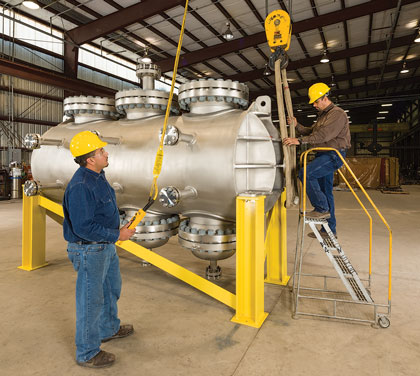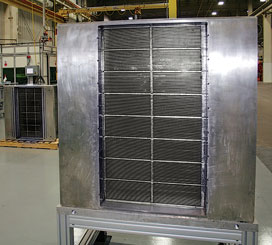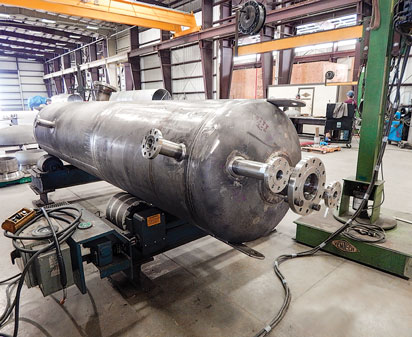Setting the stage for the future of smaller-scale GTL
N. Hargreaves, Business Development Director, Velocys, Oxford, UK
In May 1954, athlete Roger Bannister broke the four-minute-mile barrier—something that, only a few years prior, experts had stated was impossible. For Velocys, the smaller-scale GTL equivalent of that milestone was achieved in the summer of 2014, when the final investment decision was reached on what will become a commercial reference plant using its smaller-scale GTL technology.
The project, which is under construction adjacent to Waste Management’s East Oak Landfill site in Oklahoma City, Oklahoma, is expected to enter commercial production during the first half of 2016. It is being developed by a JV between Velocys, Ventech Engineers, Waste Management and NRG Energy. The JV company is known as ENVIA Energy.
ENVIA’s smaller-scale FT GTL solution. The Oklahoma City project will provide a commercial reference plant for the use of Velocys’ technology and Ventech’s modularization, and will deploy a number of Velocys’ full-scale Fischer-Tropsch (FT) reactors (Fig. 1). The project will utilize Waste Management’s pioneering landfill gas recovery and cleanup techniques, and will also benefit from NRG Energy’s significant experience in energy project development.
 |
|
Fig. 1. One of Velocys’ commercial FT reactors. |
The project will use a combination of renewable biogas and low-cost pipeline gas to produce renewable, ultra-clean fuels and chemicals. It is a landmark for GTL and its application to landfill gas on a commercial basis. Without the advances in technology brought by the JV partners, exploitation of this renewable resource in this way would not be possible, considering the volumes of gas available at any one landfill site.
Waste Management has extensive expertise in landfill gas operations at the East Oak Landfill site, which was the site of Waste Management’s pilot-scale landfill GTL unit that commenced operations in 2010. The larger commercial reference plant is being constructed at the same site because gas collection systems are already in place, and gas flow and landfill gas cleanup processes are well understood at that site.
All the main contracts for the project have been entered into, procurement of all major equipment has been completed and fabrication of the FT reactors and plant modules is underway. Groundwork has commenced at the site.
ENVIA’s Oklahoma City project is the first to be developed by the JV, which was formed to develop a series of GTL plants in the US and other select areas. The JV has identified candidate sites for possible future plants and is evaluating those and other opportunities for future project development.
The bigger picture. ENVIA Energy’s GTL plant is only scratching the surface of the potential resources available. The opportunity for smaller-scale GTL is huge.
The US Environmental Protection Agency (EPA) estimates that 250 MMtpy of municipal solid waste are sent to landfill in the US. Furthermore, the EPA estimates that 17% of total US annual methane gas released by human activity originates from US municipal solid waste landfills. Of course, landfill gas is not the only feedstock that can be used as an input to the GTL process.
Only around 5% of the world’s conventional stranded gas fields (reserves of around 1 Tcf or more) can be monetized by large-scale GTL. However, at a smaller scale, GTL has the potential to unlock up to 50% of the stranded gas fields (with sizes of 0.1 Tcf to 1 Tcf) that conventional technology cannot exploit economically. The amount of gas available to GTL in smaller, conventional gas reserves could be dwarfed by unconventional/shale gas, which is widely distributed. On the associated gas front, the World Bank estimates that 4.9 Tcf of gas is flared worldwide each year, with an additional 6.5 Tcf reinjected, at high cost, to avoid flaring.
All of these unused or wasted resources equate to a huge potential market for smaller-scale GTL. Assuming monetization over 100 years, this could amount to a market potential of 18 MMbpd from unconventional gas, 2.7 MMbpd from associated gas and 4.8 MMbpd from stranded conventional gas. In total, there is potentially an untapped market of as much as 25 MMbpd of fuel using the technology—even before considering the potential use of landfill gas, municipal solid waste and other renewable feedstocks.
Associated gas: a catalyst for change. The growing political, geological, sociological and environmental complexity of oil exploration and production has focused attention on the need to reduce flaring. Flaring regulations are in place in some of the worst-offending regions, such as Russia and the Bakken shale play in the US. However, until there is a demonstrated, economically viable alternative to the environmentally damaging practice of flaring, the political will for regulations to be widely enforced does not appear to exist.
Once a commercial reference site for GTL exists at the appropriate scale, regulations will be enforced more tightly; smaller-scale GTL could be a real catalyst for change in this area.
Producers should not expect high returns from monetizing the gas that is presently flared as associated gas. However, by removing the problem of associated gas flaring, GTL could open up larger rewards by unlocking oil production that is constrained by existing or possible future flaring regulations, thereby increasing revenues.
Not all associated gas will be suitable for monetization by GTL; a project developer would need to place a GTL plant in a strategic location where a certain amount of gas is expected to be available for the lifetime of a GTL plant (five years or more).
Also, it is improbable that smaller-scale GTL will ever be located at a single wellhead, as the volume of gas required is unlikely to be available, and the gas decline curve drops away too steeply for project economics to make sense. A key issue is gas gathering. Gas must be gathered from multiple wells coming online at different times, which tempers the normally fast decline in production rate from each well and sustains the gas flow for the duration of a GTL plant’s lifetime.
As with all projects, economics are highly location specific. The minimum plant size at which smaller-scale GTL could be deployed using this free, low-cost (or even negative-cost) associated gas will vary from site to site, although it could be economic at only a few hundred bpd of product.
Behind the scenes. The GTL process involves two main operations: the conversion of methane (from natural gas and/or landfill gas) into a mixture of carbon monoxide and hydrogen that is known as synthesis gas (syngas), followed by the FT process to convert the syngas into paraffinic (long, straight-chain) hydrocarbons.
After upgrading, a typical product slate is around 80% diesel and 20% naphtha, although jet fuel and high-value specialty products, such as solvents, lubricants and waxes, can also be produced.
Fuels produced from the FT process offer significantly better performance than their petroleum-based equivalents. FT-derived diesel does not contain aromatics or sulfur, and it burns cleaner than petroleum-derived fuels, resulting in lower emissions of nitrogen oxide (NOx), sulfur oxide (SOx) and particulates.
Use of high-purity FT diesel also reduces engine noise and wear on vital engine components. It is often blended to instill high-performance characteristics to a larger pool of fuel. Most significantly, however, the GTL process produces “drop-in” fuels that are fully compatible with existing infrastructure and engines, unlike LNG.
When the feedstock includes a renewable component, whether renewable biogas (as in the case of the ENVIA Energy project), or forestry and sawmill waste (as in the case of Red Rock Biofuels’ proposed project in Oregon), the fuels produced deliver a significant reduction in lifecycle greenhouse gas (GHG) emissions over conventionally produced fuels.
In general, fuels produced by the biomass-to-liquids process can deliver up to 90% lifecycle GHG emissions reduction compared to their petroleum-based equivalents. The US Environmental Protection Agency recently confirmed that a portion of the products produced at ENVIA’s Oklahoma City project will be eligible for cellulosic diesel (D-code 7) or cellulosic biofuel (D-code 3) renewable identification number (RIN) credits for advanced biofuel.
Scalable GTL. The FT GTL process has been proven on a world scale at Shell’s Bintulu GTL project in Malaysia and its Pearl GTL project in Qatar, as well as at Sasol’s facilities in South Africa (Secunda) and Qatar (Oryx). These plants typically produce 30 Mbpd or more of fuel and, due to logistical constraints, they can only be located at the coast.
Through the use of Velocys’ FT reactor and catalyst system, capital costs, operating costs and plant size are all significantly reduced relative to conventional GTL, making smaller-scale GTL accessible to companies other than oil majors. The success of this FT technology lies in the combination of its microchannel reactors and super-active catalysts that, together, significantly intensify the FT process.
The scalability of the technology to the volume of the feedstock available is a key benefit. The standard designs of the microchannel FT reactor itself and the trains of reactors that can be numbered up as necessary, as well as the fabrication modules, enable projects to tap into “design once, build many” approaches and economies of volume, rather than the economies of scale to which mega-scale GTL projects are limited.
 |
|
Fig. 2. FT reactor cores in production at Shiloh |
The FT reactors destined for the Oklahoma City plant are being built on a production line at Shiloh Industries’ facility in Ohio, with exacting quality control procedures, rather than being assembled in the field (Fig 2). The modules are being constructed in Ventech’s controlled factory environment, where production can continue around the clock, regardless of the weather, unlike stickbuilt mega-scale GTL plants (Fig. 3). As much as 70% of the plant can be finished before shipment to the field, reducing the risk of cost and schedule overruns common to larger projects.
|
|
|
Fig. 3. Module fabrication underway for the ENVIA Energy Oklahoma City project |
For the Oklahoma City project, the modular construction methods allowed plant construction to begin at the engineering contractor even before site construction permitting had been finalized, reducing the timescale between final investment decision (FID) and commercial operation.
In general, these advantages, based on technology enablers, mean that smaller-scale GTL realizes profits faster than mega-scale projects; it shortens the time between concept and operation. The two-year timeframe of the ENVIA Energy project from FID to commercial operation would take as many as seven years for a large, conventional GTL project. This shortened timeframe is not only due to modular construction methods; it is also a result of the choice of site with existing infrastructure and the collaboration of experienced teams prior to FID.
The impact of a low oil price. During the present period of low oil prices, many have questioned whether opportunities still exist for smaller-scale GTL.
Velocys believes that low oil prices will disproportionately impact mega-scale GTL prospects that cannot be placed in the most advantaged locations. The most recent casualty of the fall in oil prices was Sasol’s proposed GTL facility in Louisiana. The company announced in January that it would delay an FID on the GTL project to conserve cash, although it will proceed with investment in its ethane cracker to be located at the same site.
With the low oil price, proposed GTL projects aiming to take advantage of the gas arbitrage in North America will be more difficult to move forward at present. However, there are still special cases where GTL is attractive, such as local opportunities for smaller-scale GTL that are likely to retain their value, even with reduced gas-to-oil differentials at major hubs.
These projects either utilize economically priced gas or other low-cost feedstocks, or they serve a market where a premium can be realized by producing speciality products, such as base oils or waxes, or by serving isolated areas where liquid fuel import costs are high.
For example, a portion of the products planned for the Oklahoma City and the Ashtabula, Ohio GTL projects will be high-value specialty projects. This plan will help mitigate the impact of lower oil prices, since such products are sold into markets that are predominantly independent of crude oil.
Over the 20-year life of the Oklahoma City plant, there will be up cycles and down cycles in commodity prices, but the projected lifetime economics of the plant are compelling.
Ultimately, in this tougher market, quality counts. Projects need to use the most competitive technology to achieve the best economic returns. Those companies that possess vital elements—cash in the bank, supportive investors and plants that are already committed—will be well positioned to withstand market challenges and emerge at an even stronger position.
Unlocking opportunity. The ENVIA Energy GTL plant in Oklahoma City is at the forefront of the development of projects that promise to unlock the potential of landfill gas and biogas through the production of renewable, ultra-clean fuels and chemicals.
Once operational, this commercial reference plant will demonstrate the use of smaller-scale GTL for mass-market adoption using other feedstocks, such as associated gas, shale gas or smaller conventional gas reserves.
Smaller-scale GTL has the potential to achieve significant installed capacity in North America well before any large-scale conventional facility comes onstream. It is a very exciting time for the natural gas industry as a whole, and especially for the smaller-scale gas processing solutions sector. GP
 |
Neville Hargreaves has more than 20 years of experience in the oil, renewable energy and consulting industries, including 12 years with ExxonMobil. He has brought many new products to market, led two small businesses and launched a successful innovation program for the UK government. He holds an MA degree in chemistry from Cambridge University and a PhD from University College London, and he is a fellow of the Royal Society of Chemistry.






Comments